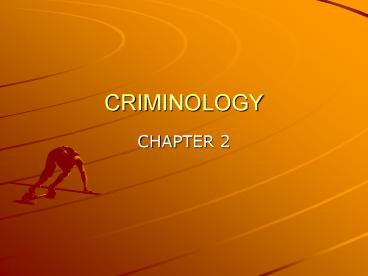CRIMINOLOGY - PowerPoint PPT Presentation
1 / 30
Title:
CRIMINOLOGY
Description:
10% - 20% of police officer time on crime. 16,000 homicides per year. ... was the subject of a Massachusetts weekend furlough program that released him ... – PowerPoint PPT presentation
Number of Views:167
Avg rating:3.0/5.0
Title: CRIMINOLOGY
1
CRIMINOLOGY
- CHAPTER 2
2
Introduction
- News media
- Our opinions about crime and criminal justice
have an impact on public policy on crime
3
Group Exercise
- Complete the questions individually.
- Then compare and discuss in groups.
- Report answers.
- Compare to actual.
4
Actual Facts
- Less than 10
- 10 - 20 of police officer time on crime.
- 16,000 homicides per year.
- 17,000 die from illegal drug use.
- Less than 10 of felonies lead to prison time.
- White male 20 year old.
5
When does news media coverage go too far?
- Video ABC NEWS 20/20 Media Hype When News
Coverage Goes Too Far
6
A Brief Look Back
- 1830s Mob violence
- 1920s crime boom Roaring Twenties.
- 1967 Presidents Commission on Law Enforcement
and Administration of Justice - Crime has always been a serious problem
politicians have used it to get elected. (George
H.W. Bush)
7
(No Transcript)
8
Major Media Event - 1932
9
Bruno Hauptmann Convicted and Executed
10
http//livingroomcandidate.movingimage.us/election
/index.php?ad_id944
- William R. Horton Jr. is a convicted felon who
was the subject of a Massachusetts weekend
furlough program that released him while serving
a life sentence for murder, providing him the
opportunity to commit a rape and armed robbery. A
political advertisement during the 1988 U.S.
Presidential race was critical of the Democratic
nominee Governor Michael Dukakis for his support
of the program.
11
TELEVISION NEWS
- Video of news interview on pursuits.
- Nightly news focus on crime.
12
Media Crime
- OFF BALANCE YOUTH, RACE CRIME IN THE NEWS.
- AVAILABLE AT www.buildingblocksforyouth.org.
13
OFF BALANCE
- The news media reports on crime are out of
balance.
14
OFF BALANCE
- Crime coverage has increased while real crime
rates have fallen.
15
OFF BALANCE
- Most media reports on youth are focused on crimes
of violence.
16
Media Research Youth
- Did you identify anything you agree with in the
report? - Do the same factors apply to adults portrayed in
the media. - Criminals?
- Victims?
- Stereotyping?
17
Public Opinion and Crime Policy
- Feature of democratic theory is policy decisions
by public officials should reflect public opinion - Criticism is politicians are influenced by small,
wealthy group rather than general public - Another criticism is majority of public opinion
violates democratic principles of fairness
18
- Public opinion is often inaccurate
- Erroneous opinions about crime and criminal
justice influence policies - What if racial prejudice affects public views
about crime?
19
Public Attitudes About Crime
- www.prenhall.com/cybrary
- Search for research on public attitudes about
crime and report what you find.
20
News Media Coverage of Crime and Criminal Justice
- Overdramatization of Crime
- Crime waves media suddenly devotes much
attention to small number of crimes - Heavy coverage increases fear of crime
- Heavy coverage of uncommon crimes (i.e. poisoned
Halloween candy, kidnapping children)
21
Overreporting of (violent) crime
- Research study indicated crime most common type
of story on TV among 13 U.S. cities - Focus on violent crime, especially homicide
- Cover crimes that occur the least
22
Crime Myths
- Crime myths False beliefs about crime
- Crime is rampant
- Crime is overly violent
- Minorities are more heavily involved in crime and
drugs - Teenagers are heavily involved in violent crime
- Crime victims are particularly virtuous
23
Other Problems in Media Coverage
- Selecting people to interview that support
reporters point of view - Using value-laden language
- Presenting misleading data
- Neglecting various forms of white collar crime
- Failing to provide social and/or historical
context - Biased picture of certain aspects of crime
24
Effects of Media Coverage
- Contributes to public ignorance
- Increases public fear and concern
- Obscures underlying forces
- Diverts attention from white collar crime
- Racial and ethnic stereotyping
25
Research on Public Beliefs about Crime and
Punishment
- Fear of Crime
- Structural factors concern the social and
physical characteristics of locations where
people live - Fear is generally higher in dilapidated minority
neighborhoods - The larger the population, the greater the fear
of crime
26
Seriousness of Crime
- Public judgments of seriousness of crime are
important for several reasons - Reflect the value placed on human life/personal
property - Affect individuals views on punishment
- Help determine appropriate penalties for
offenders
27
Punitiveness
- The Death Penalty
- Do you favor or oppose the death penalty for
people convicted of murder? - Do you favor or oppose the death penalty for
people convicted of murder, or do you favor life
imprisonment without parole?
28
Views About Police
- Satisfaction with police is lower than one might
expect - Demographic variations with respect to
satisfaction ratings - African Americans rate police more negatively
than Whites - Age and income differences
29
Individual characteristics
- demographic variable
- Age (i.e. elderly more likely to fear crime than
younger people) - Gender affects fear of crime
- Race (i.e. blacks are more fearful compared to
whites)
30
Consequences of Fear
- Paralyzes society
- Weakens social ties within the community
- Threatens economic viability of neighborhoods
- Influences public policy
- Affects individuals daily lives
31
Next Class
- Read Chapter 3.
- Group Research Project
- 1. UCR NIBRS crime reporting system.
- 2. National Crime Victimization Survey.
- 3. Self-report surveys.
- Write a one page report on your assigned crime
data system.






























